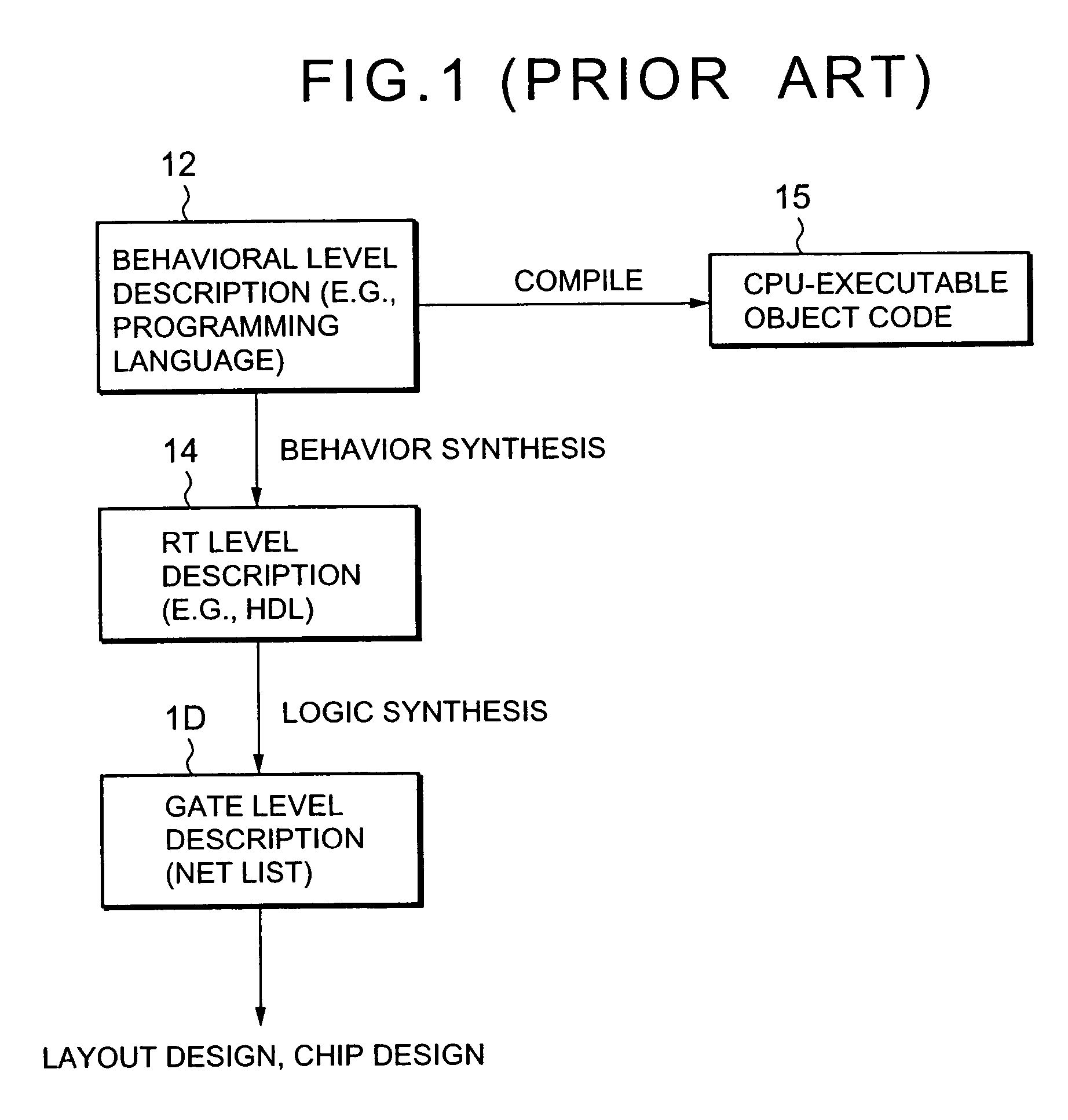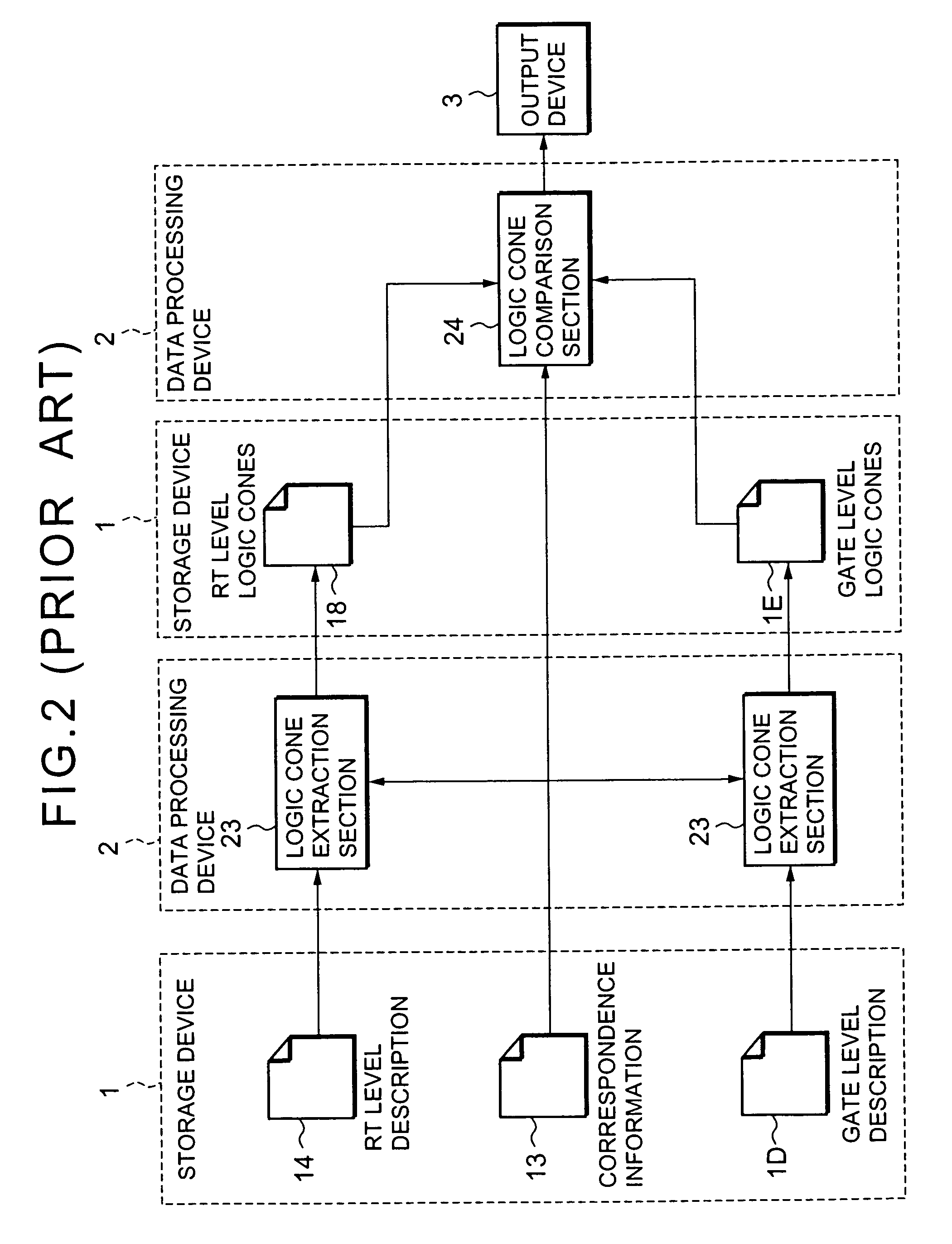Logic verification and logic cone extraction technique
a logic verification and logic cone extraction technology, applied in the field oflogic verification techniques, can solve the problems of requiring time and costs for such a task, reducing the accuracy of logic verification, and increasing the time-consuming of simulation of the rt level description b>14/b>,
- Summary
- Abstract
- Description
- Claims
- Application Information
AI Technical Summary
Benefits of technology
Problems solved by technology
Method used
Image
Examples
first embodiment
[0068]Referring to FIG. 4, a logic verification system according to a first embodiment of the present invention includes a storage device 1 which stores information, a data processing device 2 which operates under programmed control and an output device 3 such as display device or printing device.
[0069]The data processing device 2 includes a compiler 21, object code logic cone extraction section 22, HDL description logic cone extraction section 23 and logic cone comparison section 24.
[0070]The storage device 1 stores in advance a compile library 11, a behavioral level description 12 represented in a programming language, correspondence information 13 and an RT level description 14 represented in HDL.
[0071]The behavioral level description 12 is generally manually written. C, C++, Java, SystemC and SpecC are used to write the behavioral level description 12. The compile library 11, required to compile the behavioral level description 12 into an object code and execute the object code ...
examples
[0096]Operations of the first embodiment will then be described using specific examples.
[0097]Referring to FIG. 9, an example of the behavioral level description 12 written in programming language C is shown. This description designates that a function by the name of addition( ) is synthesized into a circuit by behavioral synthesis (line 11). The function addition( ) is described using variables a and b such that, each time the function is called, the cumulative sum of a variable in0 is stored in a variable out0 (lines 12 to 18).
[0098]Referring to FIG. 10, an example of the RT level description 14 converted from the behavioral level description 12 of FIG. 9 is shown. The function addition( ) in the behavioral level description 12 is implemented as a module by the name of addition (lines 1 to 13). The variable in0 is implemented as an input to the module (line 2). The variable out0 is implemented as an output from the module (line 3). Operations of the function are implemented using ...
second embodiment
[0112]A second embodiment of the present invention will then be described in detail with reference to the drawings.
[0113]The second embodiment of the present invention differs from the first embodiment in that the RT level description is given in a programming language rather than in HDL.
[0114]Referring to FIG. 19, the second embodiment of the present invention differs from the first embodiment in that the second embodiment handles extraction of the RT level logic cones 18 from the RT level description 14 by a compiler 21A and an object code logic cone extraction section 22A rather than the HDL description logic cone extraction section 23 as shown in FIG. 4.
[0115]The compiler 21A generates a CPU-executable object code 1A and compile information 1B from the compile library 11A and the RT level description 14 given in a programming language and stores the CPU-executable object code 1A and the compile information 1B on the storage device 1. The compile information 1B describes a corres...
PUM
 Login to View More
Login to View More Abstract
Description
Claims
Application Information
 Login to View More
Login to View More - R&D
- Intellectual Property
- Life Sciences
- Materials
- Tech Scout
- Unparalleled Data Quality
- Higher Quality Content
- 60% Fewer Hallucinations
Browse by: Latest US Patents, China's latest patents, Technical Efficacy Thesaurus, Application Domain, Technology Topic, Popular Technical Reports.
© 2025 PatSnap. All rights reserved.Legal|Privacy policy|Modern Slavery Act Transparency Statement|Sitemap|About US| Contact US: help@patsnap.com



